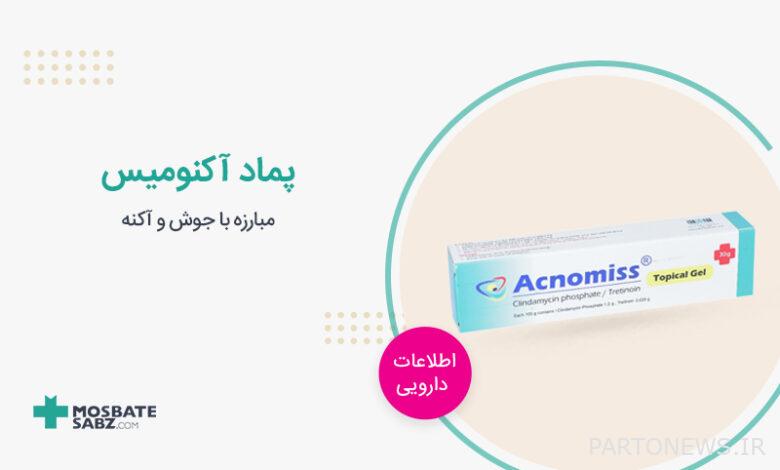What is Acnomiss ointment?

In medical science and health, new and innovative achievements in the field of development of drugs and medical treatments are continuously achieved. One of the drugs that is well known in the medical field and has a significant effect in the treatment of bacterial infections and ear infections is Akonomis ointment. Acnomys ointment is one of the popular topical medicines in the market, which is used as an effective tool in dealing with skin infections and bacterial damage. In this article, we will review important details such as uses, side effects, contraindications and precautions, mechanism of action, and clindamycin ointment.
What we read in this article
Medicinal forms of Acnomis
Chemical and herbal medicines produced in pharmacies are available in pharmaceutical forms such as tablets, syrups, serums, injectable solutions, capsules, etc. The doctor prescribes the best forms of medicine according to the physical conditions, specific medical records and the age of the patient (adults, elderly and children). Medicinal forms of Aknomys ointment, gel and lotion 1%, capsules 75 mg, 150 mg and 300 mg, injectable solution 150 mg/ml, oral solution 75 mg/5 ml, ready-to-use intravenous solution 300 ml Gram in 50 ml is 600 mg/50 ml and 900 mg/50 ml.
Uses of Acnomys medicine
This drug is used to treat a wide range of bacterial infections. This antibiotic works by stopping the growth of bacteria and only treats bacterial infections and does not work for viral infections (such as colds, flu). Using any antibiotics when they are not needed can make the medicine ineffective for subsequent infections. Some of the uses of Acnomys ointment include acne vulgaris, treatment of ear infections, sinus infections, vaginal infections and fungi.
Uses of Acnomys ointment
- Acne vulgaris
- Ear and sinus infections
- Vaginal fungi
Uses of Aknomys tablets
- Types of infection
- Serious infections caused by anaerobic bacteria
- amnionitis
- Inhalational and digestive anthrax
- Surgical prophylaxis
- Bite wound (human or animal)
- Gangrenous pyomyositis
- Oral and facial infections
- Pelvic inflammatory disease
- Toxic shock syndrome
Pharmacological effects and mechanism of action of clindamycin drug
Clindamycin (Acnomys) is an antibacterial agent that binds to the 50S ribosomal subunits of susceptible bacteria and prevents the elongation of peptide chains by interfering with peptidyl transfer, thereby suppressing protein synthesis. It reduces the surface fatty acids of the skin. The exact mechanism of action in acne treatment is unknown, but clindamycin propionate inhibits the acne bacterium in vivo. Metabolism of this drug takes place through the liver and finally it is excreted through the urine (0.2% with topical cream and solution).
The dosage of Acnomys ointment
This drug is usually prescribed 2 to 4 times a day by injection into a vein or muscle. Dosage is based on your medical condition and response to treatment. In infants, the dosage is determined based on weight. If you are taking this medication at home, ask your healthcare professional for all preparation and use instructions. Visually inspect this product for particulate matter or discoloration prior to use.
How to use Acnomys ointment (clindamycin)
- To treat acne vulgaris, apply a thin layer of ointment on the affected area every 12 hours. Use a swab to apply a thin layer of clindamycin to the affected area. Each swab should be used only once and then discarded.
- The safety and effectiveness of this product for the treatment of acne vulgaris in children under 12 years of age has not been proven.
- For children over 12 years of age, apply a thin layer to the affected area every 12 hours.
How to take clindamycin tablets
- Serious infections caused by anaerobic bacteria: 150 to 450 mg every 6 to 8 hours daily. The total amount consumed should not exceed 1.8 grams per day.
- Inhalation and gastrointestinal anthrax: 900 mg every 8 hours along with ciprofloxacin 400 mg every 12 hours or doxycycline 150-300 mg every 12 hours.
- Bacterial vaginosis: 300 mg every 12 hours for 7 days.
- Surgical prophylaxis: 900 mg one hour before surgery, which may be re-administered if necessary.
- Bite wound (human or animal): 300 mg every 6 hours can be consumed following the doctor’s instructions.
- Oral and facial infections: Use 150-450 mg every 6 hours for at least 7 days.
- Pelvic inflammatory disease: 900 mg every 8 hours with 2 mg gentamicin.
- Tablets and oral solution of this medicine have a wide application, its use and consumption requires approval and a doctor’s prescription. The above items are only a part of the general uses of this product.
Time to take Akonomis medicine
Antibiotics work best when the amount of medicine in your body is kept at a constant level. Use clindamycin at equal intervals. Continue taking this medicine until the prescribed dose is finished, even if symptoms disappear after a few days. Stopping the medication early may allow the bacteria to continue to grow, which may lead to a return of the infection. If your condition does not improve, see a doctor. The exact consumption time and amount is stated by the manufacturer on the product packaging.
Precautions
Before using Acnomys ointment, if you are allergic to the ingredients of the drug or lincomycin, refuse to use it. This product may contain inactive ingredients (such as benzyl alcohol) that can cause allergic reactions or other problems. Be careful if you have medical records such as kidney disease, liver disease, stomach or intestinal disease (such as colitis), etc. Clindamycin may also interfere with live bacterial vaccines (such as typhoid vaccine). If you are pregnant, consult your doctor about its benefits and side effects for the fetus before use, as it can affect the fetus or breast milk.
- Systemic absorption of clindamycin following topical application has been demonstrated. Discontinue use immediately if significant diarrhea occurs.
- The use of this product, especially when used with topical acne treatment, may cause irritation in some patients.
- It should be used with caution in atopic individuals.
- The ointment of this medicine is for external use only, avoid contact with eyes and mucous areas.
- If applied to the breast by nursing mothers, care should be taken to avoid accidental ingestion by the infant.
Contraindications for the use of Acnomys
All chemical and herbal medicines available in the market have precautions and contraindications. Pseudomembranous colitis has been reported with almost all antibacterial agents, including clindamycin, and may range in severity from mild to life-threatening. Oral and injectable administration of clindamycin (Acnomys) with severe colitis, which leads to death in some patients. Diarrhea, dysentery, and colitis (including pseudomembranous colitis) have been reported with oral and parenteral clindamycin, as well as with topical (dermal and vaginal) clindamycin formulations. It is important to consider this diagnosis in patients presenting with diarrhea after administration of clindamycin, even when administered vaginally.
- Hypersensitivity to clindamycin or lincomycin or any of its components
- History of regional enteritis, ulcerative colitis, or antibiotic-associated colitis (including pseudomembranous colitis)
- Not indicated for inflammatory acne
Side effects of clindamycin
Nausea, vomiting, an unpleasant or metallic taste in the mouth (if this medicine is injected into a vein), or pain at the injection site (if this medicine is injected into a muscle) and… are some of the side effects of Acnomis. If any of these effects persist or worsen, tell your doctor or pharmacist right away. Most people who use this drug do not experience serious side effects. Some serious side effects include nausea or vomiting that does not stop, pain and swelling at the injection site, dark urine, yellowing of the eyes and skin, easy bruising and bleeding, pain in several joints, fast, slow, and irregular heartbeat, fainting, symptoms Kidney problems (such as changes in the amount of urine) and…
Using this medication for long or frequent periods may lead to oral thrush or a new vaginal yeast infection. Call your doctor if you notice white spots in your mouth, changes in vaginal discharge, or other new symptoms. A very serious allergic reaction to this drug is rare. However, symptoms of a serious allergic reaction include a fever that does not go away, new swollen lymph nodes, skin rash, itching and swelling (especially of the face, tongue, and throat), etc. If these cases occur, stop taking the medicine and see a doctor.
- dryness
- being fat
- Erythema
- Exfoliation
- Burning and itching
- Headache

Drug interactions of Acnomys
Drug interactions may change how your medications work or increase your risk of serious side effects. Patients, before going to the doctor, prepare a list of the chemical and herbal medicines you use and show it to him. Pregnant women, nursing mothers, people with special medical records, infants and children should not use Akenomis ointment or tablets without a doctor’s prescription.
Use of clindamycin during pregnancy and breastfeeding
In clinical trials with pregnant women, the systemic administration of clindamycin in the second and third trimesters of pregnancy was not associated with an increase in the frequency of congenital anomalies. Adequate studies have not been conducted in pregnant women in the first trimester of pregnancy. Clindamycin should be used in the first trimester of pregnancy only if necessary.
The effect of Acnomys ointment on breastfeeding
It is not known whether clindamycin is excreted in human milk after administration, however, oral and injectable clindamycin has been reported to appear in breast milk. Clindamycin has the potential to cause adverse effects on the gastrointestinal flora of infants. If a nursing mother requires oral or intravenous clindamycin, there is no reason to discontinue breastfeeding, but an alternative drug may be preferred. Monitor the infant for possible adverse effects on the gastrointestinal flora, such as diarrhea, candidiasis (thrush, diaper rash), or, rarely, blood in the stool, indicating possible antibiotic-associated colitis.
Storage conditions for Acnomys ointment
Aknomys medicine should be stored at room temperature, away from light and moisture. Keep all chemical and herbal medicines out of the reach of children and animals. Dispose of this product properly when it has expired or is no longer needed. Avoid pouring all kinds of medicines into the toilet well, street and sewer.
The last word about Acnomys ointment (clindamycin)
Pimples or acne are among the problems that exist in most people, especially young people. Many ointments and creams have been produced by pharmacies to control and eliminate facial acne. One of these ointments, as described in this article from the Green Positive Online Pharmacy magazine, is clindamycin, which is used for a wide range of skin rashes, acne vulgaris, treatment of ear infections, sinus infections, vaginal infections and fungi.
This antibiotic only treats bacterial infections and does not work for viral infections (such as colds, flu). In case of non-prescription use, consult your doctor regarding the benefits and side effects of the product.
Site source: Medscape

